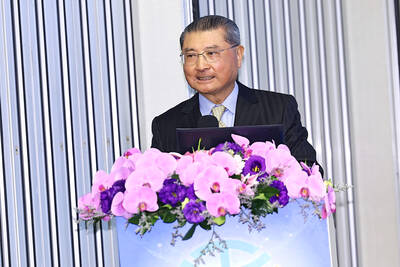The computer and information technology (IT) service sector’s revenue last quarter increased 6 percent year-on-year to NT$148.2 billion (US$4.6 billion), the highest for the July-to-September period on record, the Ministry of Economic Affairs said yesterday.
Computer programming, consultancy and other related activities reported a 3.8 percent increase in revenue to NT$106.7 billion for the quarter, boosted by strong demand for services such as systems integration, and software and hardware design, the ministry said in a report.
The IT service industry posted a 12 percent growth in revenue to NT$41.5 billion, thanks to increased demand for online gaming platforms, and cloud data hosting and processing services, it said.

Photo: CNA
In the first three quarters of the year, the computer and IT service sector also posted a record revenue of NT$435.9 billion, up 5.9 percent over the same period last year, with computer programming and IT service industries growing by 4.2 percent and 10.8 percent respectively, ministry data showed.
The technical support and professional service sector also saw revenue grow 5.8 percent year-on-year to NT$114 billion in the quarter, the highest for the same period as well, the report said.
The growth in the technical support and professional service sector’s revenue last quarter was largely due to a 10 percent increase in sales from the management and consulting industry, as more enterprises sought financial investment and management consulting, the ministry said.
It was also buoyed by the advertising and market research industry’s solid performance, which rose 3.7 percent year-on-year, and the professional design industry’s 5.9 percent revenue increase, as it benefited from robust demand for vehicle, industrial, commercial space and landscape designs, the ministry added.
However, the photography industry posted a 4 percent decrease in sales last quarter, as fewer people got married, weighing on demand for wedding photography, it said.
In the first three quarters of the year, the technical support and professional service sector’s total revenue grew 5.1 percent from a year earlier to NT$314.7 billion, with the management and consulting industry posting a 7.5 percent increase, the advertising and market research industry rising 2.4 percent, and the professional design industry seeing an 8.8 percent rise.
On the other hand, the photography industry’s revenue edged down 0.3 percent.
The rental sector posted record revenue last quarter, increasing 9.9 percent to NT$43.3 billion, mainly because the transportation rental business grew 10.6 percent amid car rental companies’ better offerings for individual and enterprise clients, the ministry said.
The rental sector’s revenue rose 9.4 percent in the first three quarters to NT$125.9 billion, the highest on record, it said.

When an apartment comes up for rent in Germany’s big cities, hundreds of prospective tenants often queue down the street to view it, but the acute shortage of affordable housing is getting scant attention ahead of today’s snap general election. “Housing is one of the main problems for people, but nobody talks about it, nobody takes it seriously,” said Andreas Ibel, president of Build Europe, an association representing housing developers. Migration and the sluggish economy top the list of voters’ concerns, but analysts say housing policy fails to break through as returns on investment take time to register, making the

‘SILVER LINING’: Although the news caused TSMC to fall on the local market, an analyst said that as tariffs are not set to go into effect until April, there is still time for negotiations US President Donald Trump on Tuesday said that he would likely impose tariffs on semiconductor, automobile and pharmaceutical imports of about 25 percent, with an announcement coming as soon as April 2 in a move that would represent a dramatic widening of the US leader’s trade war. “I probably will tell you that on April 2, but it’ll be in the neighborhood of 25 percent,” Trump told reporters at his Mar-a-Lago club when asked about his plan for auto tariffs. Asked about similar levies on pharmaceutical drugs and semiconductors, the president said that “it’ll be 25 percent and higher, and it’ll

CHIP BOOM: Revenue for the semiconductor industry is set to reach US$1 trillion by 2032, opening up opportunities for the chip pacakging and testing company, it said ASE Technology Holding Co (日月光投控), the world’s largest provider of outsourced semiconductor assembly and test (OSAT) services, yesterday launched a new advanced manufacturing facility in Penang, Malaysia, aiming to meet growing demand for emerging technologies such as generative artificial intelligence (AI) applications. The US$300 million facility is a critical step in expanding ASE’s global footprint, offering an alternative for customers from the US, Europe, Japan, South Korea and China to assemble and test chips outside of Taiwan amid efforts to diversify supply chains. The plant, the company’s fifth in Malaysia, is part of a strategic expansion plan that would more than triple

Taiwanese artificial intelligence (AI) server makers are expected to make major investments in Texas in May after US President Donald Trump’s first 100 days in office and amid his rising tariff threats, Taiwan Electrical and Electronic Manufacturers’ Association (TEEMA, 台灣電子電機公會) chairman Richard Lee (李詩欽) said yesterday. The association led a delegation of seven AI server manufacturers to Washington, as well as the US states of California, Texas and New Mexico, to discuss land and tax issues, as Taiwanese firms speed up their production plans in the US with many of them seeing Texas as their top option for investment, Lee said. The